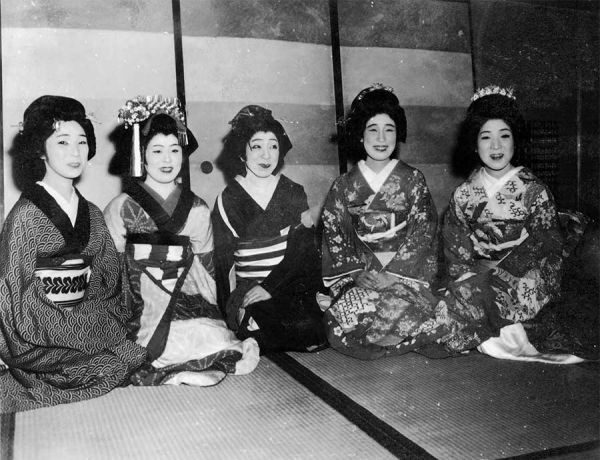Take a photo of a barcode or cover
This book will always be overshadowed by Memoirs of a Geisha (Arthur Golden heavily based his novel on interviews with Mineko Iwasaki). Despite (or in spite of) this, Geisha, a Life is 100% more worthwhile.
wonderfully written and refreshing - iwasaki mineko is a true storyteller, candid and honest, while also being able to charm the reader from the start.
emotional
informative
inspiring
lighthearted
fast-paced
Moderate: Sexual assault, Sexual harassment
Minor: Rape
Je ne sais pas ce qu'il m'a pris début décembre, mais j'ai téléchargé un énorme fichier de romans japonais. Je me suis rendue compte que malgré mon goût pour la culture nippone, je n'avais pas lu énormément de romans d'auteurs japonais. Il est temps pour moi de palier à ce petit problème et de rattraper mon retard. Mon choix s'est tout de suite porté sur Ma vie de Geisha, car j'ai vu le film il y a quelques années et j'ai encore à l'esprit une scène de danse incroyable. Je ne crois pas me tromper en disant que j'avais aimé le film, par conséquent j'imaginais que j'apprécierai tout autant le livre. En fait si j'ai tout compris, ce n'est pas de ce livre qu'est tiré le film, mais de Geisha d'Arthur Golden. En bref : j'ai confondu. Au fond, peu importe, c'était bien quand même !
C'est l'autobiographie de Mineko Iwasaki, une geisha (enfin une geiko comme on l'apprend dans le livre !) de la seconde moitié du 20e siècle, autrement dit une femme ayant vécu il n'y a pas si longtemps ! On la suit dès sa petite enfance, quand elle est plus ou moins confiée de force à un okiya (une maison de geishas) pour régler une dette de sa famille (c'est beau la marchandisation des enfants...). Quoi qu'il en soit, elle est élevée dans cette maison pour devenir une geiko, mieux l'héritière de l'okiya. On suit tout son apprentissage, c'est ce que j'ai trouvé le plus intéressant. Puis ensuite vient pour elle l'époque du succès, elle est au sommet de sa carrière. Enfin, elle se rend compte à quel point le monde change et finit par mettre fin à sa carrière.
Ce que j'ai aimé, c'est d'abord l'immersion dans un Japon traditionnel, les coutumes, l'apprentissage des geikos et tout cet univers typiquement féminin. Les geikos n'étaient pas des prostituées nom d'un nazgul en tong ! C'était des gardiennes des arts. Sauf qu'est venue la culture occidentale, l'industrialisation, le monde moderne et... J'ai beaucoup aimé cette confrontation, mais j'ai trouvé que ce n'était pas assez développé. C'est seulement sur la fin qu'on comprend que Mineko essayait de se battre pour changer les conditions de travail des geikos, pour leurs salaires, pour leur liberté, bref tout le côté engagé et social. C'est dommage parce que ça aurait pu être vraiment très intéressant à suivre, au lieu d'être expédié en quelques chapitres, comme si ce n'était pas important.
Quoi qu'il en soit, c'est une bonne lecture, je suis plutôt contente d'avoir ajouté ce livre à ma culture générale et je le conseille aux curieux du Japon.
C'est l'autobiographie de Mineko Iwasaki, une geisha (enfin une geiko comme on l'apprend dans le livre !) de la seconde moitié du 20e siècle, autrement dit une femme ayant vécu il n'y a pas si longtemps ! On la suit dès sa petite enfance, quand elle est plus ou moins confiée de force à un okiya (une maison de geishas) pour régler une dette de sa famille (c'est beau la marchandisation des enfants...). Quoi qu'il en soit, elle est élevée dans cette maison pour devenir une geiko, mieux l'héritière de l'okiya. On suit tout son apprentissage, c'est ce que j'ai trouvé le plus intéressant. Puis ensuite vient pour elle l'époque du succès, elle est au sommet de sa carrière. Enfin, elle se rend compte à quel point le monde change et finit par mettre fin à sa carrière.
Ce que j'ai aimé, c'est d'abord l'immersion dans un Japon traditionnel, les coutumes, l'apprentissage des geikos et tout cet univers typiquement féminin. Les geikos n'étaient pas des prostituées nom d'un nazgul en tong ! C'était des gardiennes des arts. Sauf qu'est venue la culture occidentale, l'industrialisation, le monde moderne et... J'ai beaucoup aimé cette confrontation, mais j'ai trouvé que ce n'était pas assez développé. C'est seulement sur la fin qu'on comprend que Mineko essayait de se battre pour changer les conditions de travail des geikos, pour leurs salaires, pour leur liberté, bref tout le côté engagé et social. C'est dommage parce que ça aurait pu être vraiment très intéressant à suivre, au lieu d'être expédié en quelques chapitres, comme si ce n'était pas important.
Quoi qu'il en soit, c'est une bonne lecture, je suis plutôt contente d'avoir ajouté ce livre à ma culture générale et je le conseille aux curieux du Japon.
emotional
informative
reflective
medium-paced
I really enjoyed the simplicity of this book and the straightforward recollection of Mineko's life.
Practically half of the book is dedicated to explaining the customs and traditions of the geiko, the origin of western misconceptions and the meaning of many of their rituals.
As a biography, I feel this book is incomplete in some aspects - one does not get the feeling of actually getting to know Mineko - but as a recollection of the experiences of a geiko, I think it is invaluable.
Practically half of the book is dedicated to explaining the customs and traditions of the geiko, the origin of western misconceptions and the meaning of many of their rituals.
As a biography, I feel this book is incomplete in some aspects - one does not get the feeling of actually getting to know Mineko - but as a recollection of the experiences of a geiko, I think it is invaluable.
emotional
informative
medium-paced
Every time I picked this book up, I fell asleep. I'm not faulting the author, but it took a lot of concentration to focus. I was not familiar with geishas and the terminology and Japanese names were confusing. Nonetheless, it was an interesting read and I have a new perception on geikos and meikos. Thanks, Rebecca!


I loved Memoirs of a Geisha, both the movie and the book. So when I found out that the Geisha on whom the book was based on or rather inspired from, has written an autobiography. Apparently, Ms Mineko Iwasaki was very upset over the way Geisha’s were portrayed by Arthur Golden and that he breached an understanding that her name was not to be mentioned anywhere, but he did, in the book as well as in interviews. She also got death threats from people who thought she had defaced Japanese culture. So she decided to write a book of her own.
Iwasaki’s parents were distraught when she decided to become a Geisha when she was just 5 years old. How a girl so young could make such a decision and how could the parents agree to it is something beyond me, even though she has tried to explain it. She goes to stay in an Okiya (a geisha house) and she is initiated into the trainings and numerous classes when she turns six.
A woman who is training to become a Geisha has a very disciplined life. There is traditional dancing, singing, playing instruments and also studying. Would-be Geisha’s are allowed to study until Junior High, in fact it’s kind of a rule.
Iwasaki excels in dancing and she is introduced as a maiko when she is 15 years old. After a few years of working as a maiko she becomes a geiko at age 21, which are the same names for a Geisha, just different hierarchies. She soon becomes one of the top geisha’s in Gion. In fact, today she almost has a legendary status.
What surprised me most was how systematic and well organized the world of a Geisha is. There is a list of all the girls that are going to come out as maiko’s. There is a Kimono Dealers association. There is a very strict hierarchy which if broken can result in serious consequences. The earnings of all the geisha’s are reported to the Geisha Committee (I think that’s whats it is), so everyone knows who the highest earning geisha for a particular year is.
The Geisha world itself is so complicated or may be I felt that way because I had not heard a lot about it. There is a rule of what kind of and what design a Kimono can have depending on seasons. Same goes for hairstyles and ornaments. It was exhausting just reading about it.
It is very clear that Ms Iwasaki loved and respected what she did and she has tried to dispel all the myth’s regarding geisha’s. She often sounds a bit egoistic and someone that could do no wrong. But we also need to understand the world she lived in, a world when no one, including one’s sister cannot be trusted. She lived by the motto: The Samurai betrays no weakness, even when starving. Pride above all. I can understand how easily pride can be mistaken for ego in the geisha world.
There are lots of minute details on a lot of things like the music school, the dance school, the different kinds of geisha’s, the customs and traditions. There are also descriptions on Kimono designs, hair ornaments and the kind. For e.g take this:
My Kimono was made out of figured satin in variegated turquoise. The heavy hem of the train was dyed in shades of burnt orange, against which floated a drift of pine needles, maple leaves, cherry blossoms and chrysanthemum petals. My obi was made of black damask decorated with swallowtail butterflies. I wore a matching obi clasp of a swallowtail butterfly fashioned out of silver.
There are many passages like these which some people may find dry and boring. But I loved them, it helped me immerse myself in the book more. In fact 2 days after finishing this book I struggled with picking up another that was as engrossing as this one.
If I have to compare this book with Memoirs of a Geisha, I would say both are very different from each other. In Memoirs of a Geisha, we get a young, naive and endearing Sayuri, where as here we get a strong willed, dedicated Mineko. Arthur Golden seems to have picked the main storyline from one of the minor characters and mixed it with Iwasaki’s story to make it more dramatic. If you are looking for a “Memoirs of a Geisha” kind of book, you will be disappointed. But both are brilliant in their own way, one as page turning fiction and one as a real look into the Japanese culture. The simple fact that Geisha, A Life is a true story gives it a different feel altogether.
Iwasaki’s parents were distraught when she decided to become a Geisha when she was just 5 years old. How a girl so young could make such a decision and how could the parents agree to it is something beyond me, even though she has tried to explain it. She goes to stay in an Okiya (a geisha house) and she is initiated into the trainings and numerous classes when she turns six.
A woman who is training to become a Geisha has a very disciplined life. There is traditional dancing, singing, playing instruments and also studying. Would-be Geisha’s are allowed to study until Junior High, in fact it’s kind of a rule.
Iwasaki excels in dancing and she is introduced as a maiko when she is 15 years old. After a few years of working as a maiko she becomes a geiko at age 21, which are the same names for a Geisha, just different hierarchies. She soon becomes one of the top geisha’s in Gion. In fact, today she almost has a legendary status.
What surprised me most was how systematic and well organized the world of a Geisha is. There is a list of all the girls that are going to come out as maiko’s. There is a Kimono Dealers association. There is a very strict hierarchy which if broken can result in serious consequences. The earnings of all the geisha’s are reported to the Geisha Committee (I think that’s whats it is), so everyone knows who the highest earning geisha for a particular year is.
The Geisha world itself is so complicated or may be I felt that way because I had not heard a lot about it. There is a rule of what kind of and what design a Kimono can have depending on seasons. Same goes for hairstyles and ornaments. It was exhausting just reading about it.
It is very clear that Ms Iwasaki loved and respected what she did and she has tried to dispel all the myth’s regarding geisha’s. She often sounds a bit egoistic and someone that could do no wrong. But we also need to understand the world she lived in, a world when no one, including one’s sister cannot be trusted. She lived by the motto: The Samurai betrays no weakness, even when starving. Pride above all. I can understand how easily pride can be mistaken for ego in the geisha world.
There are lots of minute details on a lot of things like the music school, the dance school, the different kinds of geisha’s, the customs and traditions. There are also descriptions on Kimono designs, hair ornaments and the kind. For e.g take this:
My Kimono was made out of figured satin in variegated turquoise. The heavy hem of the train was dyed in shades of burnt orange, against which floated a drift of pine needles, maple leaves, cherry blossoms and chrysanthemum petals. My obi was made of black damask decorated with swallowtail butterflies. I wore a matching obi clasp of a swallowtail butterfly fashioned out of silver.
There are many passages like these which some people may find dry and boring. But I loved them, it helped me immerse myself in the book more. In fact 2 days after finishing this book I struggled with picking up another that was as engrossing as this one.
If I have to compare this book with Memoirs of a Geisha, I would say both are very different from each other. In Memoirs of a Geisha, we get a young, naive and endearing Sayuri, where as here we get a strong willed, dedicated Mineko. Arthur Golden seems to have picked the main storyline from one of the minor characters and mixed it with Iwasaki’s story to make it more dramatic. If you are looking for a “Memoirs of a Geisha” kind of book, you will be disappointed. But both are brilliant in their own way, one as page turning fiction and one as a real look into the Japanese culture. The simple fact that Geisha, A Life is a true story gives it a different feel altogether.





